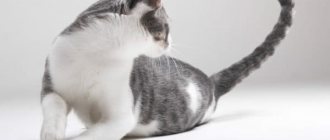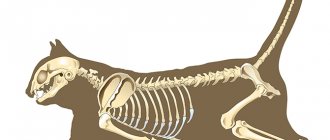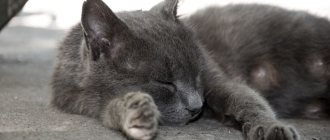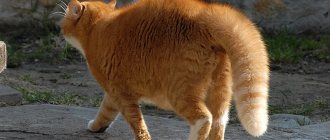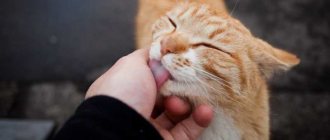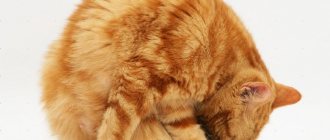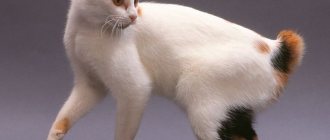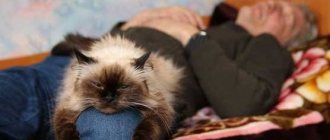15.09.2019
| no comments
How to understand a cat's language ? It’s very simple, of all the “foreign” languages, cat is the simplest, you just have to study the cat’s behavior in certain situations, and everything immediately becomes clear: is the cat happy, or are serious feline passions boiling in her “soul”.
Cat behavior is worth studying if only because they can be trained like dogs. You just need to understand cat language. Cats are not stupid, but they are a little willful, but if you understand them, you can make a great friend.
True, cats are not as attached to people as dogs, but they can become more attached to a person than to a house. A cat or cat may miss its owner during separation, not allowing strangers near it, even if the cat is on its own territory.
From such separations, the cat can even get sick, for example, cystitis . While cats themselves are able to relieve stress and normalize blood pressure, cats are so sensitive to any negative energy.
It’s not for nothing that cats were considered sacred animals in ancient Egypt. And even now, both men and women love cats for their beauty, for their grace, for their playful character, and for many other reasons. But, unfortunately, we don’t always understand cats.
Cat sign language
As the cat Matroskin said from the cartoon “Three from Prostokvashino”: “Whiskers, paws and tail - these are my documents.” And this statement is not far from the truth. These cat body parts can tell their owner a lot. You can tell a cat's mood by its whiskers (whiskers). When they are lowered, it means that the cat is upset about something.
A cat takes a “milk step” with its paws when it is happy. This is how kittens stimulate the release of milk from the mother cat’s nipples. This action reminds her of moments of bliss, and the cat may “purr” with pleasure.
If a cat has a “pipe” tail, this means that it greets its owner.
To the main “cat documents” you can add a bunch of small, but very important certificates.
For example, a cat's dry nose indicates that she may be sick. Or just woke up.
Some time after the cat wakes up, you can check the nose again; if it is wet, then everything is fine. A cat's nose is very sensitive to odors.
Cats do not like the smell of alcohol, and history describes a case where a cat relieved itself on the head of a drunken owner, and, in the end, weaned him off drunkenness.
Cats are also sensitive to changes in atmospheric pressure. If a pet hides its nose, it means that there will be a cold snap soon. This can also be indicated by paws that are turned upside down. If the cat sleeps, stretched out to its full length, be warm.
When a cat washes itself and rubs its ears vigorously, it means it’s about to rain. Or there is a popular saying: “the cat rake in the guests.”
Cats have very sensitive hearing. They hear in the range from 55 Hz to 79 kHz (dogs - from 67 Hz to 44 kHz). The ability to hear ultrasound helps them hunt.
This incredible sensitivity is enhanced by moving ears, and cats clearly know where the noise is coming from. It's no surprise that cats sit in front of front doors long before anyone rings the bell.
This way they can greet the owner, or inform the owners that guests are coming.
Compared to cats, people are blind and deaf. But the idea that cats see in complete darkness is wrong.
Dialects of the cat language
Each cat can show its joy or dissatisfaction in its own way. But cat language definitely has its subtleties.
The same tail can say a lot: if a cat slowly shakes the tip of its tail, it means it is happy, an angry animal will beat its tail on the surface if it sees an enemy, while its ears will be pressed tightly back, and its body will be arched to visually appear larger . The mother cat will play with her tail with the kittens, imitating the game of cat and mouse.
Some cats will expose their tummy to be stroked.
But most cats demonstrate their complete trust to their owner in this way, and will immediately dig their teeth and claws into the hand, as soon as their belly is touched. Moreover, they will add active actions with the hind legs.
The latter makes them similar to representatives of the cat family from the wild. Leopards, for example, use the same technique to gut their prey.
By the way, a cat can bring a caught mouse to its owner. This is how she shows her owner her friendliness, considering him not a person, but a friend - a cat, or cat.
Cats can be very picky when it comes to food. Cats, like people, can be lactose (milk sugar) intolerant. Due to lactase deficiency, such cats do not digest milk (manifests in the form of diarrhea).
Cats don't like frozen foods and won't eat anything they don't like. They have a good memory. But after a delicious meal, cats lick their lips with pleasure.
They also lick during stress, but this action looks completely different under stress.
The vocal abilities of cats are simply inimitable. They can meow, purr, purr, snort, growl and even howl or chirp, giving their voice almost a hundred different intonations. Cats can imitate the cries of a hungry child, and then these sounds are especially difficult to ignore. Particularly talkative cats can make sounds reminiscent of human speech.
For example, like in this cool video about a cat saying the word “mom”.
Cats can sit on our laps for hours, not because of money or any other self-interest, but simply out of boundless love.
They can lift our spirits . That's what they are, these cats and cats.
Source: https://happylady.su/povedenie-koshki-koshachiy-yazyik-azbuka-ot-nosa-do-konchika-hvosta/
How to determine your pet's mood by its tail
The communicative function is one of the main ones for the tail. By waving it, the animal can demonstrate a whole range of emotions, from hatred to all-consuming love. Everything matters: the direction of movements, their amplitude and speed.
What does the position of a cat's tail indicate?
A complete dictionary of the “tailed” language could look like this:
How else can a cat “talk”?
The tail is not the only way a cat can show its attitude. Animals have quite a lot of visual aids: ears, paws, and the whole body. Quite often they convey information using sound signals.
Interesting!
Tailless cat breeds are becoming increasingly popular. Now there are several dozen of them. Some are already recognized as felinologists, others are just winning their hearts. The owners of such pets claim that the absence of a fifth limb does not interfere with their mutual understanding.
The human-cat dictionary can be supplemented with the following sections.
Communication using the body
Cat conversations can involve the whole body. With the help of movements, the animal is able to convey all important information and clarify details “left unsaid” by the tail.
| Gesture | Image | Designation |
| “I’m interested”, “I’m listening to you” | ||
| “I am completely happy, calm and content” | ||
| “There’s danger somewhere nearby, but I’m on my guard.” | ||
| “I acknowledge your superiority”, “I’m bored” | ||
| “I love you”, “I want to please you” | ||
| “You are only mine”, “Stroke me” | ||
| “I trust you completely”, “I love you” | ||
| “I need your attention”, “Stroke me” | ||
| “I feel danger, but I want to avoid a fight”; “Let’s resolve everything peacefully or I can’t vouch for myself” | ||
| "I will fight" |
Communication using glances
Eyes also play a huge role in dialogue. By studying the cat's language of views, you can not only learn to understand your pet, but also respond to him in such a way that he understands.
- bulging eyes, unblinking gaze - “I am the strongest here, go away”, “Fear me”;
- squinting, blinking - “I like you”, “I feel calm and comfortable.”
Advice!
If you want to convey to your pet that you love him and will never hurt him, squint a little and look carefully into his eyes. And then blink slowly a few times.
Communication using sounds
Scientists estimate that cats can make about 30 different sounds. Each has its own meaning. Sometimes it is difficult for a person to distinguish one from the other. The owner’s ear may not be able to detect the change in timbre and volume. But there is a rule that will help determine the mood of the pet giving the sign. The lower his “meow” sounds, the more negative emotions he experiences.
The basic sounds that cats make can be translated into human language as follows:
Read also: Instagram targeting tips of the year
- the usual even meow - “I need attention”, “Show me how you love me”;
- loud insistent meowing - “Give me something to eat”, “Pour me some water”, “Open the door for me”;
- deep guttural growl - “I’m very angry”, “Everyone disperse!”;
- hissing - “I’m scared, but I will defend myself to the last”, “Now I’ll give you a beating”;
- purring - “I feel very good”, “Keep doing what you are doing”;
- squeal - “It hurts!”
Interesting!
Some scientists suggest that cats make sounds only for humans, and their communication with their relatives can take place in complete silence. However, there are also opponents to this theory. Their main arguments are the voices that newborn kittens make and the “concerts” that adults throw only for “their own.”
How cats communicate using their tails
It is not always possible to understand from the face how to determine the mood of the animal and figure out what the cat wants. And it is the cat’s tail that will tell you about all the thoughts and emotions of the pet. Let's look at specific examples of why and how a cat twitches its tail:
- The four-legged pet smoothly swings its tail horizontally in different directions. Cat experts indicate this gesture as the fact that she cannot immediately make a choice between her desires. When the decision is made, the animal will calm down and stop twitching;
- if a cat lifts its tail and puts it vertically, it tells you that the pet’s thoughts are very interested in something;
- a slight twitch indicates strong affection and love for you;
- if the cat’s fifth limb is down, it means that she is bored;
- the tail is up, but the back is arched and the ears are pressed back - the cat cannot decide whether to attack or defend. He is very scared;
- the tail is in a curved arc position and the cat arches its back - it senses danger and is ready to defend itself. In this state, do not hit her and try to calm her down;
- a tail raised up (vertically) indicates that the animal is in a great mood and is ready for games and communication;
- a loosely drooping tail tells that the pet is in a calm mood, but is not inclined to communicate;
- a measured and rather strong horizontal waving of the tail indicates dissatisfaction and irritation;
- a wary animal's tail is lowered and ruffled;
- only the tip of the tail moves slightly - at the moment the pet is in an excellent mood and is happy with everything that is happening around him;
- the cat’s tail trembles and moves horizontally in different directions faster and faster - the hunt is in full swing and an attack on the prey will occur in the coming seconds;
- a vertically extended, quivering tail denotes a playful mood. It’s worth considering here that if the movements become faster and sharper, the cat beats its tail and may start meowing - the animal is getting too excited and it’s time to stop it. This is especially true when playing with small children - the danger of scratches and bites from a cat is too great;
- a tail wrapped in a ring around the body speaks of an excellent mood and trust in the surrounding world;
- the tail is raised halfway - the pet is confused and cannot determine its attitude towards a person or animal - to understand whether it is a friend or an enemy;
- fluffy tail and fur along the spine - the cat is furious;
- a vertically raised tail may mean that the cat is marking territory;
- sharp waving or tapping indicates stress and possibly pain;
- biting the tail signals the presence of parasites;
- in cold weather, cats wrap their tail in a ring around themselves, thereby reducing heat transfer;
- a vertically raised tail with a relaxed tip indicates joyful excitement;
- sits or lies with the fifth limb calmly extended - the cat is resting;
- in a sitting position, with paws tucked and tail wrapped - the animal is relaxed, but waiting for some action;
- a slight twitching of the whole body along with the tail means happiness and calmness of the pet. You can observe this when stroking it, scratching its ears or back. Will also be expressed in loud purring and squinting of the eyes;
- a leisurely and rhythmic twitching of the tail vertically indicates interest in something. The cat is relaxed, does not feel danger and is concentrated on the object of its attention. It is also expressed in the fact that the animal walks around the object of its interest and sniffs it;
- the desire to attack can be expressed in walking the fifth limb from side to side. If this occurs when playing with inanimate objects, then there is no need to worry. As soon as the cat gets tired of this activity, it will move away from it and forget about it quite quickly. At least until the next surge in gaming activity.
INTERESTING TO FIND OUT: Why does a cat shed a lot?
Cats move their fifth limb almost constantly. There are many explanations for this fact. When communicating, you just need to pay attention to your pet’s mood. When there is mutual understanding between the owner and the pet, when they can understand and feel each other, then there will be practically no problems in communication.
Just listen to what your cat is telling you. Indeed, contrary to popular belief, tail twitching can also mean great love and devotion towards you.
Why do cats wag their tails?
The cat waves its tail differently, the movements reflect a certain emotion, positive or negative. The cat shakes its tail with a certain intensity, proportional to the strength of the emotions experienced.
Kittens often catch and bite their own tail, which acts as a toy and helps them acquire hunting skills.
Since a cat has an individual character and behavior, tail movements may not mean what is commonly believed. Therefore, it is recommended to determine cat emotions from your own experience, focusing on the information presented.
Positive reasons
There are many positive reasons why cats noticeably wag their tails:
- are in a playful mood and invite you to play;
- express love for the owner and household members (the vertically raised tip trembles);
- show interest, curiosity (slight twitching);
- they feel happiness, satisfaction, express complete calm (they move only the tip of their tail);
- express friendliness and trust (the caudal vertebrae are parallel to the floor);
- experience the excitement of the hunt, observe a potential victim - a mouse, a fly, a bow on a rope;
- are thoughtful (broad, relaxed movements);
- feel satisfied, want to communicate (the caudal process is lowered, relaxed);
- feel superiority and security, are confirmed in leadership (hold the organ like a “pipe”);
- thank the owner for his care and affection (the cat slowly and smoothly waves its tail).
Functions provided by nature
Unlike human tail vertebrae, which have become useless vestiges, felines still perform all the functions that nature intended for them. These include:
- balancing;
- communication;
- status indicator;
- temperature adjustment.
Let's look at each of these functions in more detail, not forgetting to mention one more - entertainment. She will explain to you what the tail is for a recently lambed cat and why adult animals experience increased stress when meeting hyperactive kittens.
Perfect balance
When telling why a cat has a tail, it’s worth starting with the function of the steering wheel. With its help, the animal skillfully avoids skidding, climbs trees, makes jumps, stays on a narrow ledge and even navigates in the dark.
When falling from a great height, the tail begins to rotate and twitch intensively, helping the body to take a safe position for it. This is why mustachioed pets often land on 4 paws without getting hurt or hurt.
Communication method
Most owners don’t even hesitate when answering why a cat has a tail. Every day they are faced with the fact that mustachioed pets shake or wag their fluffy fan while communicating.
Unlike humans, the main way animals communicate is non-verbal. They use sign language to interact with other four-legged animals and their owners. Thanks to the movement of the tail, you can understand not only the desires of your pet, but also its mood.
Emotion screen
The range of emotions conveyed by a cat's tail is very wide. The most common ones can be found in the table below.
| Emotion | Ponytail position | Other signs |
| Anxiety |
|
|
| Playfulness |
| |
| Calm |
|
|
| Malice |
|
|
| Happiness |
|
|
| Pain |
|
|
| Fear |
|
|
With each subsequent function, it becomes more and more clear why cats have tails. But its capabilities are not limited to coordination and communication. The comparison with the fan was given for a reason, because another useful function of the tail is thermoregulation.
To have something to brush off
The fluffy fan cools the body very well in hot weather. But that’s not all a cat needs a tail for. By wrapping it around its nose, muzzle and paws, the mustachioed pet successfully warms up frozen parts of the body. This feature allows you to create the desired microclimate in any weather conditions.
The tail can be a toy!
Small predators do not try to understand why a cat has a tail - they simply attack it, mistaking it for a potential prey. For this reason, adult animals often suffer from restless kittens who want to play with their wealth.
Grown-up cats rarely chase someone else's or their own tail. If they are nevertheless noticed doing this strange thing, they quickly lose interest in it.
(cat sign language)
If you want to understand your animal, be sure to watch its postures. Still, you can’t rely one hundred percent on your hearing. And the cats
, like no other animals, can use facial expressions and gestures to explain what is on their mind. When we talk, some of our messages are conveyed non-verbally, that is, not through speech, but through changes in facial expression, gestures, posture and gaze. Cats also make significant use of these non-verbal signals, which perfectly convey their feelings.
If a cat butts its head
If your pet bangs its head against you, as if trying to butt you, this is an expression of sympathy for the owner. This is how the cat demonstrates its trust or expresses gratitude, for example, for a delicious dinner.
Do cats do this in the evenings when you return home after a day of work? They thereby ask for affection. Surely your tailed friend has already gotten bored and in his sign language demands your attention, wants to be petted.
Some experts believe that cats mark their territory in this way. On the forehead, lips and chin, as well as on the tail and paw pads, cats have glands that secrete special pheromones. When a cat rubs against its owners, or, for example, against the furniture that surrounds it, it thereby puts a mark on them. Subsequently, by smell it will not be difficult for her to distinguish her own from the “strangers”.
Other emotions
The tail will also tell you about other features of the cat’s mood. Let's see what else his movements say .
- A thoughtful wagging of the tip of the tail - something attracted the cat's attention. She listens, sniffs, looking for an object that interests her, and moves her tail to the beat of her “reflections.” At such moments it becomes like a question mark.
- Calm wiggles while playing with the owner demonstrate her good disposition and pleasure from having fun together. However, during gameplay the cat may begin to cross the boundaries of permitted behavior. This will be noticeable by the accelerating movements of the tail, which may be followed by painful bites and scratches on the person.
- Cats wag their tails vertically when they are either sexually aroused or want to play.
- When a cat, instead of waving its tail, taps it on the floor with small nervous movements, this means that it is not just nervous, but is experiencing stress. Also, tapping often indicates that your pet is in pain. Having noticed that the cat began to wag its tail in this way, the owner needs to be alert and provide assistance to the animal.
Some owners notice that the cat constantly wags its tail when dozing. Smooth, gradually subsiding movements indicate that the animal is comfortable, it feels safe and is gradually going to sleep. Having fallen soundly asleep, cats sometimes also begin to twitch their tail. Scientists believe that they dream and react to them in a similar way. Having noticed such body movements in a sleeping pet, the owner need not worry - his pet is simply “chasing” another mouse in his sleep.
© shutterstock
Resentment
Cats are vulnerable and vindictive. The slightest inattention on the part of the owner will not go unnoticed and in the morning you can find a puddle in your slippers. Making cats feel guilty by punishing them or reproaching them is a useless exercise. Cats are not familiar with feelings of guilt. What is it that upsets and offends your pet so much?
- Indifference (the cat will not forget this and will weave intrigues);
- Loud screams (the pet will hide and feel depressed);
- Throwing objects at cats or hitting them (serious offense, forgiveness will have to be earned).
Why does a cat have a tail?
There is a belief that a cat should not be pulled by the tail, otherwise it will start shitting in inappropriate places. It is unclear what this statement is based on, but the tail of cats and cats really needs to be handled carefully. Damage to this organ requires immediate veterinary intervention. Sometimes it even has to be amputated.
A cat's tail is an extension of its spine. It consists of approximately 2-3 dozen vertebrae, thanks to the mobility of which animals wave their tail. There are also many nerve endings there. That's why cats almost always show anxiety when their owners touch their tail. When treated with such disrespect, they begin to wag at them anxiously.
Initially, nature gave cats this organ not for communication with humans. The tail helps the animal:
- ensure body balance when jumping;
- coordinate movements when walking on narrow surfaces;
- maneuver when falling;
- navigate in complete darkness;
- when in contact with other animals, give them various signals (for example, warn that the cat is ready to attack).
However, over the thousand-year history of cat domestication, she has learned to use tail wagging to “talk” with humans. An experienced and attentive owner recognizes by its movement how his pet is feeling, whether the animal needs to be supported, or, on the contrary, left alone. Cat body language is very informative, and knowing it will greatly benefit the owner.
Structure
The answer to the question why a cat needs a tail, from an anatomical point of view, is extremely simple - it is an integral part of the body, an extension of the spine. The cat's tail consists of several vertebrae, five of which at the very base are large with a canal for the spinal cord, the rest are smaller and do not have an opening. The very tip of the tail is a special miniature vertebra of a pointed shape.
All parts of the tail are movably connected to each other and are separated by intervertebral discs. There can be 20-27 segments in total depending on the breed. The most “tailed” cats are not large maincoons, as one might think, but Norwegian forest cats. Their spine length can reach 40 cm. Moreover, their tails are extremely fluffy and voluminous.
Like the spine, the pride of every self-respecting cat is particularly flexible, which allowed breeders to obtain breeds with a tail that curls almost into a dog “donut”. Such cats are called ringtail, but nature and breeders decided not to stop there. This is how the Manx and Bobtail appeared - exclusively short-tailed or completely tailless animals.
By observing the behavior of cats in their natural habitat and at home using modern video and photo cameras, scientists figured out why the cat needs this “extension of the spine.”
What does it mean when a cat wags its tail?
Everyone knows that the tail
- This is not only a decoration for a cat. It helps to successfully land on the ground or floor when jumping from a height, to balance fearlessly on fences and tree branches, coordinating the balance of the animal. And the tail of mustachioed pets is a real mood indicator. Unable to express their emotions through words, our smaller brothers use body language. And, perhaps, the movements of a cat’s tail can demonstrate to the owner what the animal is experiencing, more eloquently than any meow.
Is it possible to treat on your own?
Many pet owners who have encountered the problem described remember their confusion in the first minutes when they discovered that the cat’s tail was broken and were at a loss what to do. You need to realize that if we are talking about a fracture, then you cannot do without the help of a specialist. It is the veterinarian who will make the correct diagnosis and prescribe the necessary treatment.
At home, you can try to treat a dislocation yourself (if you are confident in the diagnosis) or a fracture not complicated by displacement. In this case, a tight bandage of a special fixing bandage is applied to the damaged area, which will protect it from unnecessary movements. The bandage is applied for 3 weeks.
But in this case, you need to be prepared for some problematic issues that arise during treatment: it is rarely possible to apply a bandage tightly enough, a sick cat can scream and struggle, and remove the fixing bandage on its own (in this case, experts recommend putting a special collar on the animal).
Why you shouldn't pull your pet's tail
The cat should not be pulled by the thin tail vertebrae. According to popular belief, the pet will begin to defecate in the wrong corners. In reality, these actions are cruel, physically unpleasant for the animal, cause discomfort, and often cause injury and illness.
A bully, grabbing a cat wagging its tail, can injure the vertebrae, requiring surgical assistance or amputation.
Often hooligan actions lead to paralysis of the hind limbs and urinary incontinence in the pet.
Cats are vengeful, tugging and squeezing - which means humiliation of dignity - does not forgive, they begin to take revenge.
How cats show their mood
A cat's tail consists of many vertebrae and performs a large number of functions. The main role is balancing during movement and hunting. But a cat's tail is also an expression of her behavior and character. This means that if the owner is attentive and loving, then it will be easy for him to determine the cat’s mood by the tail. It is when and how a cat shakes its tail that you can understand what mood it is in.
A cat's tail twitches in different ways - both vertically and horizontally. To figure out how to understand a cat by its tail, you need to take into account many factors. These may include:
- people unfamiliar and incomprehensible to them. For older cats, this can be a stressful environment. And if this is a cat with kittens, then the trembling tail will immediately let you understand displeasure and fear for its offspring;
- general situation in the breeder’s family. If you constantly scream and at the same time can periodically hit the kitten, you should be prepared for the fact that the cat arches its back and its tail is fluffed or tucked. But when you love and cherish your pet, then his tail will almost always be a pipe, and the threat of an arched back and hissing sounds will bypass you;
- If an animal beats its tail, meows, shakes, its pupils are dilated and it tucks or arches its tail, then the pet is letting you know that it is experiencing fear. In such a situation, it is better to remove the object that provoked panic;
- An unfamiliar environment or moving can also cause displeasure in the pet, which will be expressed in the fact that the cat jerks its fifth limb. Let her know that you are looking out for her and want the best for her.
INTERESTING TO KNOW: Why does a cat drool?
Cats can perfectly understand what you are communicating with them about. As the kitten grows up, it learns to understand its owner, and you learn how to determine its mood and how to understand your pet’s language.
The tail is pipe-shaped and slightly rounded at the tip.
The arched back and the upturned, tousled tail are a reaction to danger or threat. This means that the cat is ready to attack at any moment, and it is better for others not to try to come into contact with the animal.
A vertically positioned vibrating tail indicates pleasure and a state of bliss in which the pet is, for example, when meeting its owners after a long day of work. This gesture can often be seen in kittens who are exploring the world around them or happily running towards a bowl of milk. Young animals often show their pleasure this way during active play with some kind of bait.
All these gestures are quite easy to remember; all that remains is to react correctly to the pet’s behavior. For an observant owner, recognizing a cat's behavior at home will be easy. This way you can understand what exactly pleases or annoys your pet and increase the comfort of living with him.
Cat behavior is worth studying if only because they can be trained like dogs. You just need to understand cat language. Cats are not stupid, but they are a little willful, but if you understand them, you can make a great friend.
True, cats are not as attached to people as dogs, but they can become more attached to a person than to a house. A cat or cat may miss its owner during separation, not allowing strangers near it, even if the cat is on its own territory.
From such separations, the cat may even get sick, for example, cystitis. While cats themselves are able to relieve stress in humans and normalize blood pressure, cats are so sensitive to any negative energy.
It’s not for nothing that cats were considered sacred animals in ancient Egypt. And even now, both men and women love cats for their beauty, for their grace, for their playful character, and for many other reasons. But, unfortunately, we don’t always understand cats.
Cat sign language
As the cat Matroskin said from the cartoon “Three from Prostokvashino”: “Whiskers, paws and tail - these are my documents.” And this statement is not far from the truth. These cat body parts can tell their owner a lot. You can tell a cat's mood by its whiskers (whiskers). When they are lowered, it means that the cat is upset about something.
A cat takes a “milk step” with its paws when it is happy. This is how kittens stimulate the release of milk from the mother cat’s nipples. This action reminds her of moments of bliss, and the cat may “purr” with pleasure.
If a cat has a “pipe” tail, this means that it greets its owner.
How to tell how a cat is feeling by its tail
The movements of a cat's tail can serve as an indicator of health. Having fallen ill, the animal will begin to make movements that were previously unusual for it. This is a sign that you need to take a closer look at your pet’s behavior and, if you notice other warning signs, contact your veterinarian.
You can tell how your cat is feeling by the movement of his tail.
Attention! Sharp twitching of the tail can be a signal that the animal has reached puberty and is experiencing excitement. If a pet shakes its tail when near a wall or piece of furniture, it means it is marking its territory.
The following table will help you understand what is happening in your pet’s body.
| Disease | Tail movement | Other signs | Image |
| Rabies | Sharp convulsive twitching of the tail and back | Refusal of water while maintaining appetite, excessive salivation, aggression or attempts to hide | |
| Neurosis | Chaotic twitching of the tail and whole body | Excessive licking, leading to deterioration in coat quality | |
| Parasite infestation | Sudden twitching of the tail and back of the back | Frequent scratching, sudden movements, attempts to catch fleas with teeth | |
| Oncological diseases | Frequent, chaotic movements of the tail | Lethargy, lack of appetite | |
| Tail injuries | Tail tucked | Lethargy, irritability, lack of appetite |
For all its simplicity, a cat's tail is capable of performing a wide variety of tasks. With its help, a pet can not only talk about its feelings, but also hint at its well-being. Therefore, it is so important for every responsible owner to know this special language.
Feeling jealous
There are legends about cat jealousy. They very clearly show their indignation when a newborn appears in the family or a new pet (kitten or puppy). The cat considers himself a royal person and the master of your apartment, and believes that any major changes must be agreed upon with him. Small nasty things from the still cute and calm cat cannot be avoided. Do not rush to give it to other hands, let it get used to new circumstances. After all, the cat experienced enormous stress; a rival appeared on his territory, encroaching on his unlimited power. The cat is afraid of losing the love of its owner, be patient and understanding. And with new pets, it is better to demarcate the territory, at least until they become friends.
Cats are happy and sad. They are able to experience not only emotions, but also a feeling of love. Each of them has their own favorite toys, food and favorite places in the house. Take care of your pets, and they will thank their beloved owner with their warmth and tender affection.
